Introduction: The Invention of Transformer
The electricity flowing seamlessly through our homes and powering our devices doesn’t magically appear at the perfect voltage. The invention of transformer ensures efficient and safe electricity transmission. While often unseen, this ingenious device has revolutionized how we utilize electricity, playing a central role in the modern world.
This blog delves into the fascinating story of the electric transformer:
- From Frustration to Invention: We’ll explore the challenges faced by early electrical pioneers and the need for a solution that led to the development of the transformer.
- The Spark of Innovation: We’ll meet the brilliant minds behind the transformer, highlighting their contributions and the evolution of transformer design.
- A World Transformed: We’ll examine the profound impact of the transformer on various industries and daily life, showcasing its significance in shaping our modern electrical infrastructure.
So, join us on this electrifying journey as we explore the invisible powerhouse – the electric transformer!
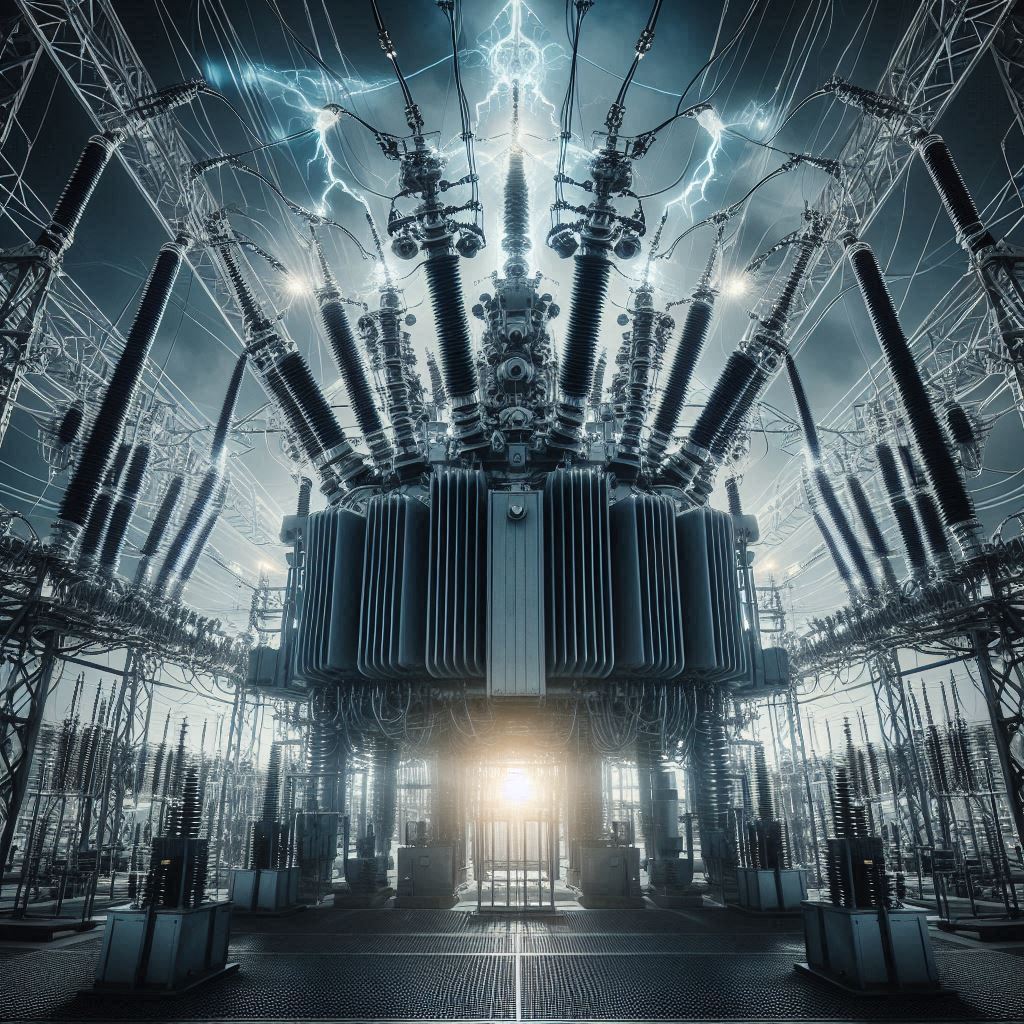
What is a Transformer?
A transformer is an electrical device that changes the voltage level of alternating current (AC) electricity while keeping the frequency constant. It works on the principle of electromagnetism consisting of two coils of wire, known as the primary and secondary coils, wound around a shared magnetic core.
The primary coil is connected to the power source, and when an AC voltage is applied to it, it generates a changing magnetic field in the iron core. This changing magnetic field, in turn, induces an electrical voltage in the secondary coil through a process called electromagnetic induction.
The key principle behind a transformer’s operation is Faraday’s law of electromagnetism, which states that a changing magnetic field induces an electromotive force (EMF) in a nearby conductor. In the case of a transformer, the primary coil creates the changing magnetic field, and the secondary coil captures the induced voltage.
The voltage transformation ratio is determined by the number of turns in the coils. If the primary coil has more turns than the secondary coil, the transformer will step up the voltage. Conversely, if the secondary coil has more turns, the transformer will step down the voltage.
Working Principle of a Transformer:
Electromagnetic Induction:
A transformer consists of two coils, the primary coil (input) and the secondary coil (output), wound around a common iron core. When an alternating current (AC) flows through the primary coil, it generates a changing magnetic field around it. This changing magnetic field induces a voltage in the secondary coil, which transforms electrical energy from one coil to the other.
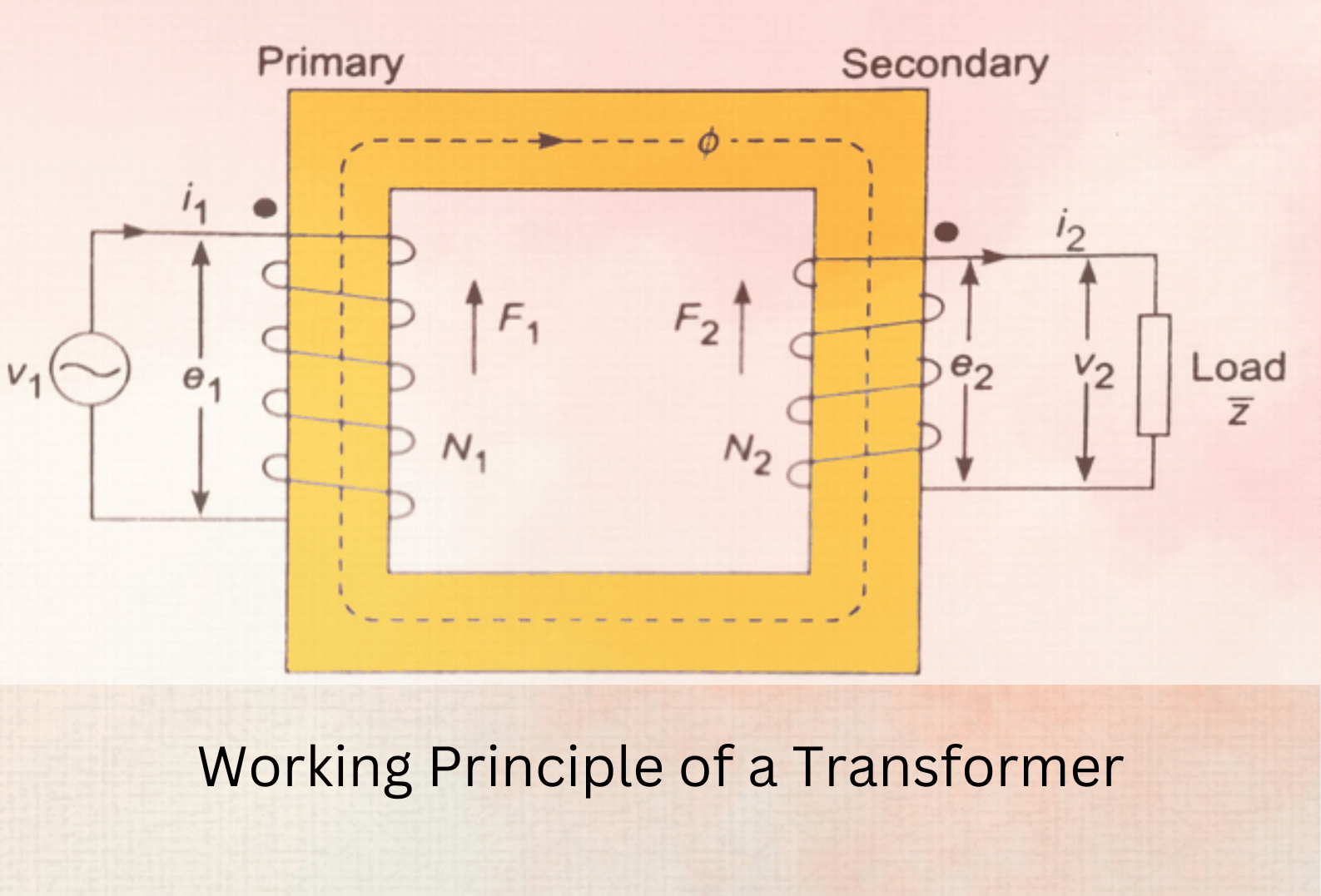
Faraday’s Law of Electromagnetic Induction:
Faraday’s law states that the induced voltage (E) in a coil is directly proportional to the rate of change of magnetic flux (Φ) through the coil. The equation for Faraday’s law is:
E=-N ×d⁄ϕdt
Where,
E- is the induced voltage.
N- is the total number of turns in the coil.
(dϕ⁄dt)
represents the rate of change of magnetic flux.
Transformer Components:
A transformer consists of the following key components:
Primary Coil (Input):
This coil is connected to the source of electrical power. When AC current flows through the primary coil, it creates a changing magnetic field.
Secondary Coil (Output):
The secondary coil is where the transformed electrical energy is output. The induced voltage in the secondary coil depends on the number of turns in the coil.
Iron Core:
The iron core provides a path for the magnetic flux and enhances the efficiency of the transformer. It acts as a magnetic circuit, concentrating the magnetic field.
Magnetic Flux:
The magnetic flux (Φ) represents the total magnetic field passing through the coils. It is directly proportional to the number of turns and the current in the primary coil.
Turns Ratio:
The turns ratio ( N1⁄N2) is the ratio of the number of turns in the primary coil (N1) to the number of turns in the secondary coil (N2). It determines the voltage transformation.
The equation for the turns ratio is:
N1⁄N2=V1⁄V2
where, V1 and V2 are the voltages across the primary and secondary coils, respectively.
Step-by-Step Working:
Transformers operate based on the principle of electromagnetic induction. They consist of two coils of wire – the primary coil and the secondary coil – wrapped around a soft iron core. When an alternating current (AC) is applied to the primary coil, it creates a changing magnetic field in the iron core. This changing magnetic field, in turn, induces an electric current in the secondary coil.
The key to understanding transformers lies in the ratio of the number of turns in the primary and secondary coils. This ratio determines the voltage and current output:
Step-Up Transformers: If the secondary coil has more turns than the primary coil, the voltage is increased (stepped-up) at the output. However, according to the principle of energy conservation, the current in the secondary coil is decreased. Step-up transformers are crucial for power transmission over long distances. Since high-voltage electricity experiences lower energy loss during transmission, step-up transformers increase the voltage at power plants before sending it through transmission lines.
Step-Down Transformers: Conversely, if the secondary coil has fewer turns than the primary coil, the voltage is decreased (stepped-down) at the output, while the current is increased. Step-down transformers are essential for local distribution of electricity and powering our appliances. They receive high-voltage electricity from the transmission lines and reduce it to safe and usable levels for homes and businesses.
The Transformer Family Tree:
Beyond the basic step-up and step-down categories, transformers come in various forms, each with specific applications:
Distribution Transformers: These workhorses are the most common type of transformer. They are typically mounted on utility poles or housed in underground vaults, stepping down high-voltage electricity from the transmission lines to the lower voltages needed for residential neighborhoods and commercial buildings.
Power Transformers: These heavyweights reside in power generation plants and substations. They handle massive amounts of electrical power at very high voltages, playing a crucial role in transmitting electricity from power plants to the transmission grid.
Isolation Transformers: Safety is paramount! Isolation transformers provide electrical isolation between the primary and secondary circuits. This prevents current from flowing directly between them, which can be crucial for protecting sensitive equipment from electrical noise or ground faults.
Autotransformers: These transformers offer a more compact design with a single, common winding that serves as both the primary and secondary coil. While they boast efficiency and size benefits, they provide less isolation compared to traditional transformers.
Historical Journey of the Transformer
The electric transformer’s journey is a fascinating tale of human ingenuity overcoming challenges and shaping the modern world. This timeline delves into the key milestones that led to this essential technology:
Early 19th Century: Michael Faraday’s Electromagnetic Induction
In 1831, Michael Faraday, a renowned British physicist with a relentless curiosity about electricity, made a groundbreaking discovery that would lay the foundation for the transformer. Through his experiments, Faraday established the principle of electromagnetic induction. This principle states when the conductor is placed in a changing magnetic field it induces an electric current in the conductor. This fundamental concept became the cornerstone of the transformer’s operation.
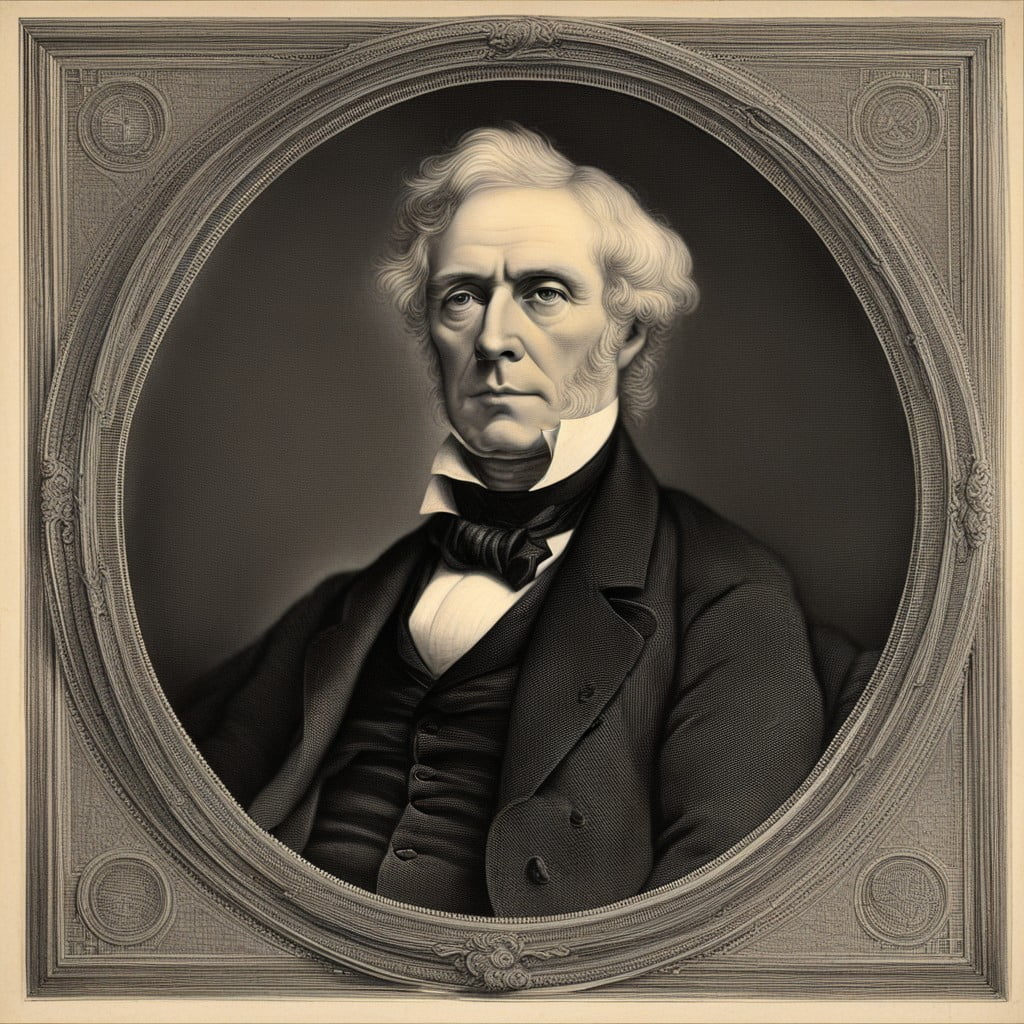
Historical Significance:
Faraday’s discovery, documented in his “Experimental Researches in Electricity” series published between 1832 and 1855, marked a significant turning point in the world of electricity. It paved the way for numerous inventions and advancements, including the transformer, which would revolutionize power transmission and distribution years later.
Further Exploration:
- Michael Faraday’s “Experimental Researches in Electricity” series
- Biography of Michael Faraday
1836: Nicholas Callan’s Induction Coil
While not credited with inventing the transformer itself, Irish inventor Nicholas Callan made significant contributions in the early 1830s. He developed the induction coil, a device consisting of two nested coils of wire wrapped around a soft iron core. When a current was passed through the primary coil, a changing magnetic field was induced, generating a high voltage in the secondary coil. This invention, documented in his 1836 paper “On a New Form of Galvanic Battery” in the Philosophical Magazine, served as an early precursor to the transformer, demonstrating the potential of using changing magnetic fields to manipulate electricity.
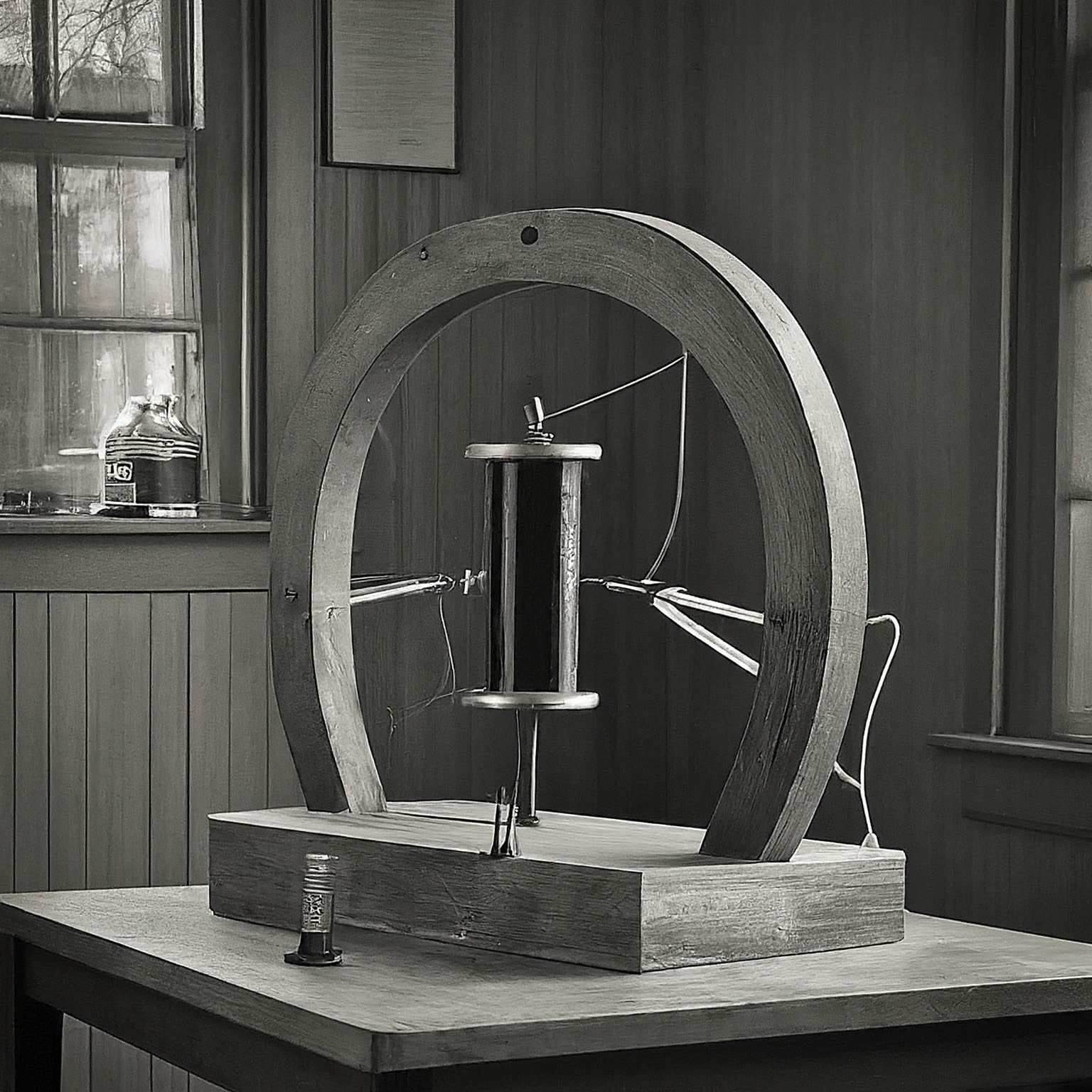
1847-Ruhmkorff coil:
Heinrich Ruhmkorff: Taking it Further: Building upon Callan’s work, German physicist Heinrich Ruhmkorff developed the Ruhmkorff coil in 1847. This improved version of the induction coil employed a more robust design and insulation, allowing for the generation of even higher voltages. The Ruhmkorff coil found applications in various fields, including early experiments in X-rays and wireless communication.
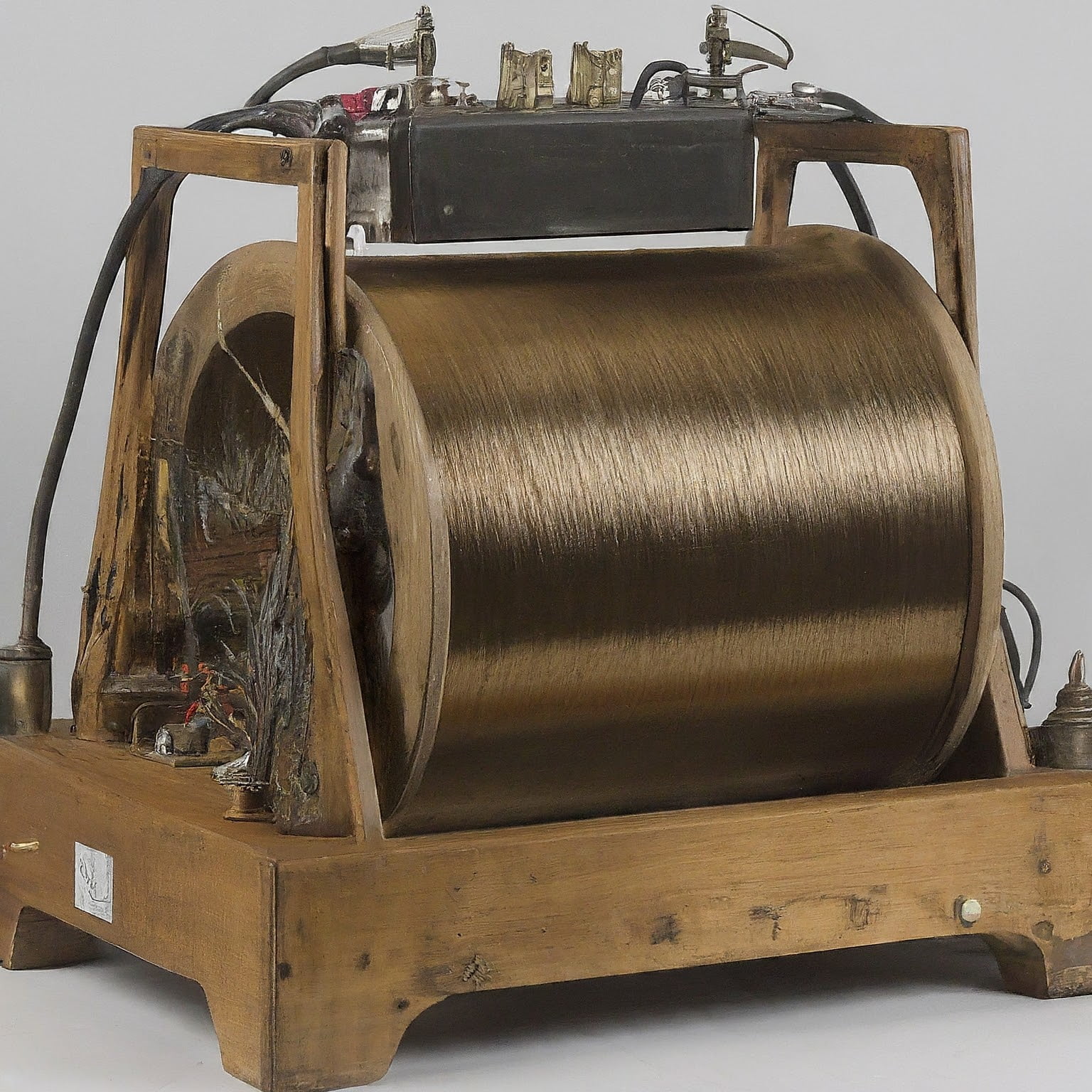
Historical References:
1870s – 1880s: The Need for Change Emerges
The Struggle with Distance and Direct Current:
The late 19th century witnessed a surge in enthusiasm for electricity, but a significant hurdle stood in the way of widespread adoption: distance. Direct current (DC), the dominant form of electricity at the time, experienced significant energy loss when transmitted over long distances. This limited the reach of power plants and hindered the electrification of large areas.
Seeking a Solution: The Rise of Alternating Current (AC)
Visionary minds like Nikola Tesla and George Westinghouse began advocating for alternating current (AC) as a solution. While AC faced initial resistance due to safety concerns and patent disputes, its inherent advantage in long-distance transmission offered a glimmer of hope. However, a crucial missing piece remained: a way to efficiently transform voltage.
1882-1883: The Ganz Works and Early Experiments with AC Lighting
In Budapest, Hungary, the Ganz Works, a leading electrical engineering company, became a breeding ground for innovation. Led by the brilliant engineer Miksa Déri, a team including Ottó Blathy and Károly Zipernowsky began experimenting with AC lighting systems. They utilized induction coils, devices that transferred electrical energy from one circuit to another through a changing magnetic field. These experiments, while not yet transformers in the true sense, laid the groundwork for the groundbreaking invention that was to come.
Historical References:
- “The History of Electric Lighting” by Henry M. Hobart: This book provides a historical overview of the development of electric lighting, including the challenges faced with DC transmission and the rise of AC.
- “Tesla: Inventor of the Electrical Age” by Margaret Cheney: This biography delves into Nikola Tesla’s contributions to AC technology and his vision for a world powered by AC electricity.
1884: A Critical Step Forward – Gaulard and Gibbs’ “Secondary Generator”
In 1884, Lucien Gaulard and John Dixon Gibbs, a French and an English engineer respectively, presented their “secondary generator” in London. This device, while not perfect, utilized a laminated iron core to improve efficiency in transferring energy from a primary circuit to a secondary circuit. Although their design received some criticism at the time, it marked a significant step towards the development of a practical transformer.
Website:
- IEEE History Center – “Lucien Gaulard and John Dixon Gibbs“: This webpage from the IEEE History Center provides a brief biography of Gaulard and Gibbs and their contributions to AC technology.
1885: Birth of the Transformer
The year 1884 witnessed growing frustration with the limitations of direct current (DC) power transmission. While efficient for short distances, DC suffered significant energy loss over longer spans. In search of a solution, engineers across Europe were experimenting with alternating current (AC) systems.
One such effort came from Lucien Gaulard and John Dixon Gibbs, who showcased a device called a “secondary generator” in London. This early design, though flawed, hinted at the potential of transformer technology.
Budapest Boldness: Ganz Works and the Déri-Blathy-Zipernowsky Transformer
Meanwhile, in Budapest, Hungary, a team at Ganz Works, led by the brilliant engineer Miksa Déri, was determined to crack the AC transmission code. Déri, along with his colleagues Ottó Bláthy and Károly Zipernowsky, tirelessly experimented with induction coils and iron cores.
Their relentless efforts culminated in a breakthrough: the Déri-Blathy-Zipernowsky transformer, patented in 1885. This pioneering design marked a significant departure from previous attempts. It incorporated a closed iron core to efficiently channel the magnetic field, and utilized multiple coils to achieve the desired voltage transformation ratios. The Déri-Blathy-Zipernowsky transformer offered a practical and efficient solution for both stepping up voltage for long-distance transmission and stepping down voltage for powering homes and businesses.
Historical References:
- A Magyar Villamosság Története (The History of Hungarian Electricity): This Hungarian-language book by Tibor Szép offers a detailed account of the development of electrical engineering in Hungary, including the story of the Déri-Blathy-Zipernowsky transformer.
- “The Zerener Lectures on Electrical Theory” by Charles Proteus Steinmetz (1908): This classic text by a prominent American electrical engineer provides historical context for the development of transformers and AC power systems.
Websites:
- Hungarian Patent Office website: You can find the original Hungarian patent for the Déri-Blathy-Zipernowsky transformer (in Hungarian) through the Hungarian Patent Office website.
Late 1880s – Early 1900s: A Race for Refinement
The Race Heats Up: Stanley, Tesla, and the Battle of the AC Systems
News of the Déri-Blathy-Zipernowsky transformer sparked a global race for AC power system development. In the United States, William Stanley, working for Westinghouse Electric, developed his own transformer design in the late 1880s. Stanley’s transformer, while inspired by the Hungarian invention, incorporated some key modifications, such as using an air core for certain applications.
Meanwhile, the visionary inventor Nikola Tesla emerged as a strong advocate for AC power transmission. He developed his own transformer design and, in collaboration with George Westinghouse, actively promoted the AC system against the dominant direct current (DC) technology championed by Thomas Edison.
Studies and Historical Context:
- “The War of the Currents” by Richard Moran (2006): This book delves into the historical rivalry between Thomas Edison and Nikola Tesla, highlighting the competition between DC and AC power systems in the late 19th century.
- “AC vs. DC: The Historical Background” by Martin J. Klein (2012): This scholarly article published in the journal “Technology and Culture” provides a deeper analysis of the technical and economic factors that influenced the adoption of AC power systems.
1886: A Pivotal Year – Great Barrington Lights Up with AC Power
The year 1886 witnessed a significant milestone. The world’s first commercial AC power system, utilizing transformers designed by William Stanley, went into operation in Great Barrington, Massachusetts. This successful demonstration proved the practicality and efficiency of AC transmission with transformers, paving the way for the widespread adoption of AC power grids across the globe.
Websites:
- IEEE Global History Network – The Electrification of Great Barrington: This webpage on the IEEE Global History Network offers a detailed account of the pioneering AC power system in Great Barrington, Massachusetts.
- Edison Tech Center – History of Transformers: This website by the Edison Tech Center provides a historical overview of transformer development
1891: The Three-Phase Revolution with Dolivo-Dobrovolski
The year 1891 marked a pivotal moment in the history of the transformer. A brilliant Russian engineer, Mikhail Dolivo-Dobrovolski, entered the scene with a groundbreaking invention: the three-phase transformer. This innovation proved crucial for powering the burgeoning use of alternating current (AC) motors in industrial applications.
Dolivo-Dobrovolski’s Legacy:
Dolivo-Dobrovolski wasn’t just an inventor; he was a pioneer in the field of polyphase electrical systems. While other prominent figures like Nikola Tesla were exploring AC motors, Dolivo-Dobrovolski focused on the practical challenges of transmitting and utilizing AC power effectively. His prior work on three-phase generators and motors laid the groundwork for the three-phase transformer.
The Triumph of Three-Phase:
In 1891, Dolivo-Dobrovolski showcased his achievements at the International Electro-Technical Exhibition in Europe. There, he not only unveiled the three-phase transformer but also demonstrated its effectiveness by transmitting electricity over a staggering 176 kilometers (109 miles) with an impressive 75% efficiency. This feat underscored the superiority of three-phase systems for long-distance power transmission compared to single-phase systems prevalent at the time.
Historical References:
- Mikhail Dolivo-Dobrovolsky: This Wikipedia page provides a detailed biography of Dolivo-Dobrovolski, highlighting his contributions to polyphase systems and the three-phase transformer.
- A historical perspective on the development of polyphase systems: This webpage by the Federal Aviation Administration (FAA) offers a historical timeline that mentions Dolivo-Dobrovolski’s role in developing three-phase systems.
Early 1900s: A Global Transformation
The early 1900s witnessed the rapid spread of transformer technology across Europe and the United States. This innovation revolutionized power grids, enabling:
- Long-Distance Electricity Transmission: Transformers played a critical role in overcoming the limitations of DC transmission. By efficiently stepping up voltage for transmission over long distances and then stepping it down for local distribution, transformers made it possible to deliver electricity to geographically dispersed areas.
- Growth of Industrial Applications: The widespread adoption of AC motors in factories and industries was fueled by the availability of reliable and efficient AC power made possible by transformers.
- Electrification of Homes and Businesses: The ability to transmit and distribute electricity effectively using transformers paved the way for the electrification of homes and businesses, ushering in a new era of convenience and productivity.

Standardization and Safety:
As transformer technology proliferated, the need for standardization became paramount. Standardized voltage levels and manufacturing practices ensured compatibility between different systems and prioritized safety across the growing electrical grid.
Studies and Websites:
- The Electrification of America, 1880-1940: This book by historian Ronald G. Baer explores the social and economic impact of electrification in the United States, highlighting the role of transformers.
- National Electrical Manufacturers Association (NEMA): The website of the National Electrical Manufacturers Association (NEMA) offers information on electrical standards and safety regulations related to transformers and other electrical equipment.
1914: The Age of Oil-Filled Transformers
The year 1914 marked another significant development in transformer technology: the introduction of the oil-filled transformer. These transformers offered two key advantages:
- Improved Cooling: Oil provided a more efficient cooling medium compared to air, allowing transformers to handle larger loads and operate at higher voltages.
- Enhanced Insulation: Oil offered superior insulation properties, minimizing electrical leakage and improving overall safety.
The oil-filled transformer design paved the way for the development of larger and more powerful transformers, further solidifying their role as the backbone of modern power grids.
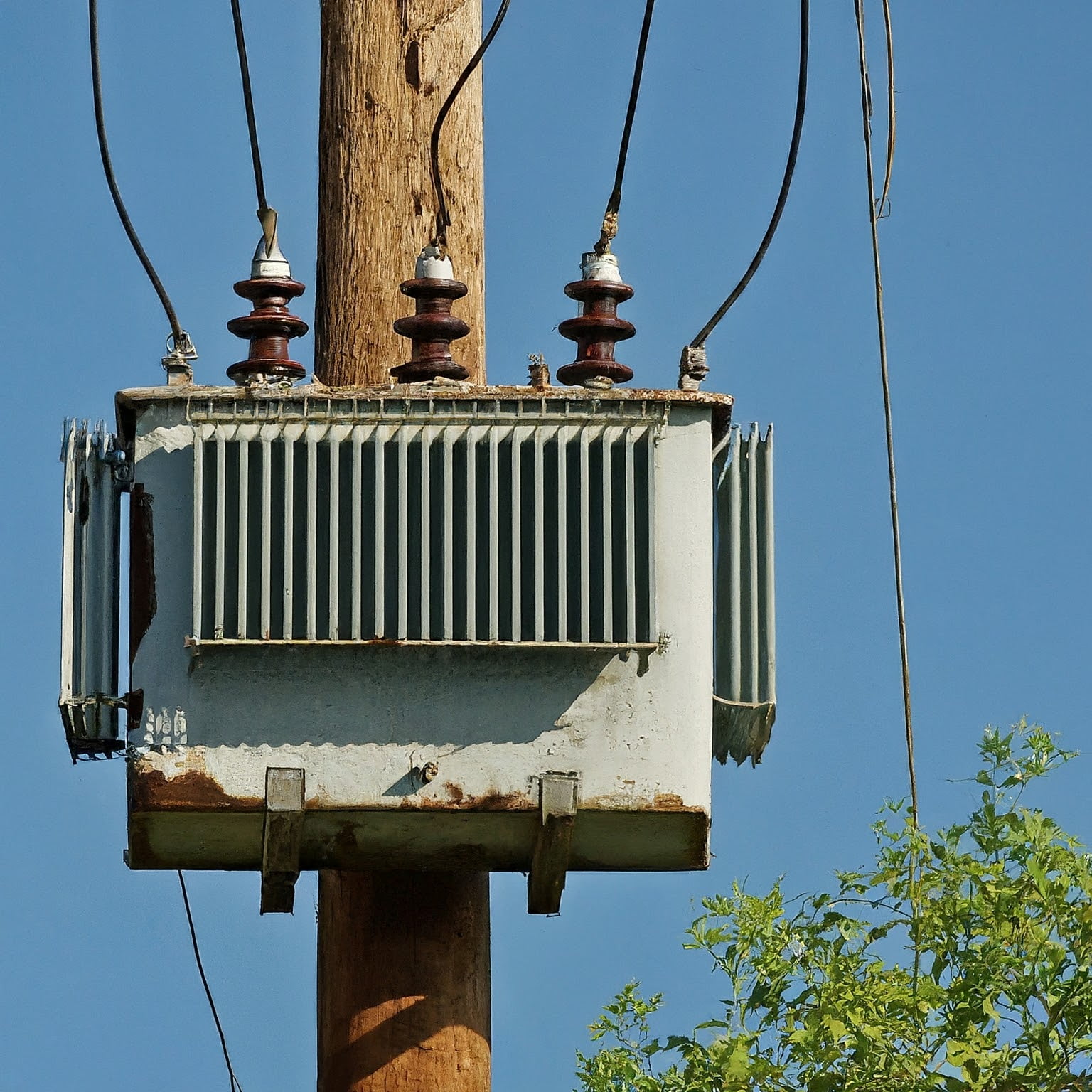
Further Reading:
- Evolution of Power Transformers: This webpage by Siemens Energy showcases the historical development of power transformers, including the transition to oil-filled
Mid-20th Century: Specialization and Diversification
Transformers continue to evolve, with the development of specialized types like:
Distribution Transformers: William Stanley
- Story of the Inventors: The concept of the distribution transformer can be traced back to the pioneering work of William Stanley in the late 1880s. Stanley, an American engineer, is credited with developing one of the first practical transformer designs that enabled the efficient distribution of AC electricity. His work, alongside that of European inventors like Miksa Déri, laid the foundation for the distribution transformers we see today.
Historical References:
- A pivotal moment in the history of distribution transformers occurred in 1886 with the establishment of the first commercial AC power system utilizing transformers in Great Barrington, Massachusetts. This successful demonstration marked a turning point, showcasing the practicality of AC transmission with transformers for powering homes and businesses. You can find more details about this event in historical accounts by the Edison Tech Center or the National Geographic Society.
Websites:
- For a deeper understanding of distribution transformer design and operation, check out these resources:
- EE Power – Distribution Transformers: This website by electrical engineering educator Jeff Parr offers a clear explanation of distribution transformer functions and their importance in the power grid.
Power Transformers: The Heavy Hitters of High-Voltage Transmission
Story of the Inventors:
- The development of power transformers is intertwined with the advancements in high-voltage AC transmission systems. Mikhail Dolivo-Dobrovolski, a Russian engineer, played a crucial role in this area. In 1891, he invented the three-phase transformer, a significant breakthrough that enabled efficient transmission of electrical power over long distances using three-phase AC systems.
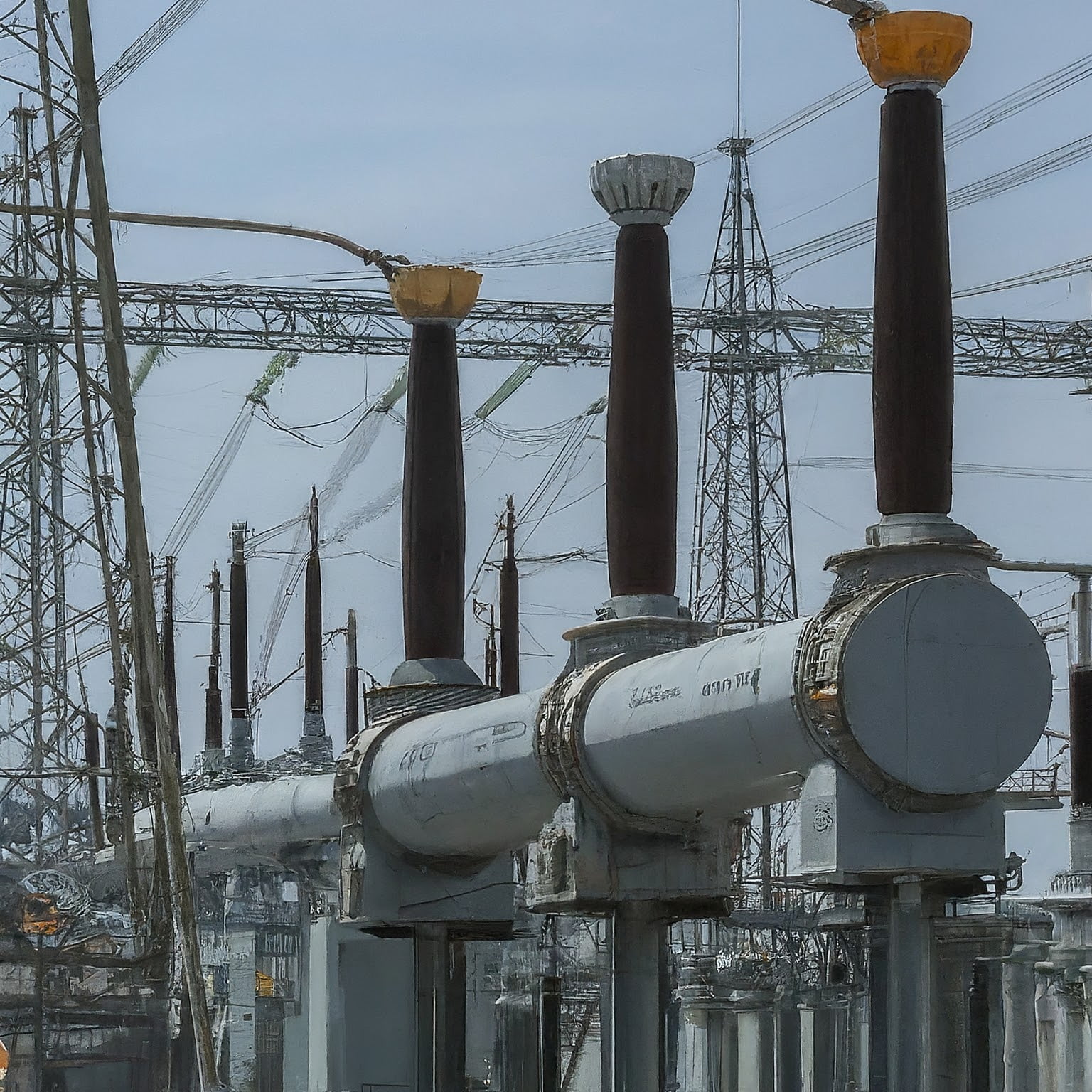
Historical References:
- The early 20th century witnessed a surge in power transformer development to meet the growing demand for electricity in cities and industrial centers. A historical account by the American Society of Mechanical Engineers (ASME) details the evolution of power transformers and their impact on the development of large-scale power grids.
Websites:
- GE Grid Solutions – Power Transformers: This website by a leading manufacturer provides an overview of different power transformer types and their applications in power generation and transmission.
- Institute of Electrical and Electronics Engineers (IEEE) – Power Transformer Protection: This webpage from the world’s largest professional association for the advancement of technology explores the crucial role of protection systems for safeguarding power transformers.
Isolation Transformers: Ensuring Safety and Reducing Noise
Story of the Inventors:
- The concept of isolation transformers emerged from the need for improved safety and noise reduction in electrical circuits. While the exact inventor is not pinpointed, the development of isolation transformers is attributed to the collaborative efforts of electrical engineers in the early 20th century.
Historical References:
- The importance of isolation transformers became evident in applications involving sensitive electronic equipment susceptible to electrical noise and ground faults. A study published in the 1950s by the National Bureau of Standards (NBS) (now the National Institute of Standards and Technology or NIST) explored the effectiveness of isolation transformers in mitigating ground currents and improving equipment safety.
Websites:
- Magnetics Inc. – Applications of Isolation Transformers: This webpage by a leading magnetics manufacturer details various applications of isolation transformers, including noise reduction and medical equipment safety.
Late 20th Century and Beyond: Material Advancements and Efficiency
The late 20th century ushered in a new era for transformers, driven by advancements in material science. These advancements led to increased efficiency, reduced size for specific applications, and a continued push for even more innovative designs:
- Amorphous Metals: A Higher Efficiency Frontier: The introduction of amorphous metal transformers marked a significant leap forward. Unlike traditional silicon steel cores, amorphous metals offer a more uniform atomic structure, resulting in lower hysteresis losses (energy loss during magnetization) and higher efficiency. This translates to reduced energy consumption and operational costs in power grids.
Websites:
- IEEE Spectrum – Amorphous Metal Transformers: This article explores the benefits of amorphous metal transformers and their potential impact on the power grid:
Beyond Efficiency: Exploring the Future of Transformer Materials
Research and development efforts are not limited to just efficiency improvements. Engineers are continuously exploring novel materials to push the boundaries of transformer design:
- Nanocrystalline Alloys: Redefining Efficiency Limits: Nanocrystalline alloys are a promising new class of materials with exceptional magnetic properties. These alloys possess even lower core losses compared to amorphous metals, potentially paving the way for ultra-efficient transformers. Research into incorporating these materials into transformer cores is ongoing.
Websites:
- ScienceDirect – Nanocrystalline Soft Magnetic Materials: This scientific paper delves into the properties and applications of nanocrystalline alloys:
- High-Temperature Superconductors: A Dream of Lossless Transmission: The holy grail for transformer design might lie in high-temperature superconductors. These exotic materials exhibit zero electrical resistance at specific temperatures. Theoretically, transformers built with superconductors could achieve lossless power transmission, eliminating energy waste entirely. While significant challenges remain in terms of cost and practicality, research in this area continues to be a focal point.
The Present and Future: A Legacy of Innovation
The transformer’s story is one of continuous adaptation and improvement. From the early days of iron cores to the exploration of cutting-edge materials, these advancements ensure that transformers remain a vital component of the modern electrical grid. As our energy needs evolve, future research will likely focus on:
- Smart Transformer Technology: Integrating sensors and communication capabilities into transformers will enable real-time monitoring, improved grid management, and self-healing capabilities for enhanced reliability.
- Sustainable Materials: Developing transformers with environmentally friendly materials and improved life cycles will be crucial for a sustainable future.
The transformer’s journey is far from over. As we strive for a more efficient and sustainable electrical grid, this remarkable invention will undoubtedly continue to evolve, playing a pivotal role in powering our world for generations to come.
Current and Future Trends: Grid Integration and Electrification
Transformers continue to be at the forefront of grid integration for renewable energy sources. The increasing adoption of wind and solar power necessitates innovative transformers to efficiently convert and distribute this energy. Electrification initiatives, such as the electrification of transportation and industrial processes, are also driving the development of advanced transformers to meet evolving energy needs and ensure a sustainable future. As technology continues to advance, transformers will play a central role in shaping the future of the electrical power industry.

These historical developments paved the way for the practical use of transformers in electrical power systems, leading to their indispensable role in modern electricity distribution.
Conclusion
In conclusion, the transformer is a remarkable device that has played a pivotal role in the transmission and distribution of electrical power. Its invention was the result of a series of scientific discoveries, innovations, and engineering efforts that have shaped the modern world. From Faraday’s principles of electromagnetic induction to the development of various transformer types, the journey of the transformer is a testament to human ingenuity and progress in electrical engineering.
Also, check out the relevant blogs:






